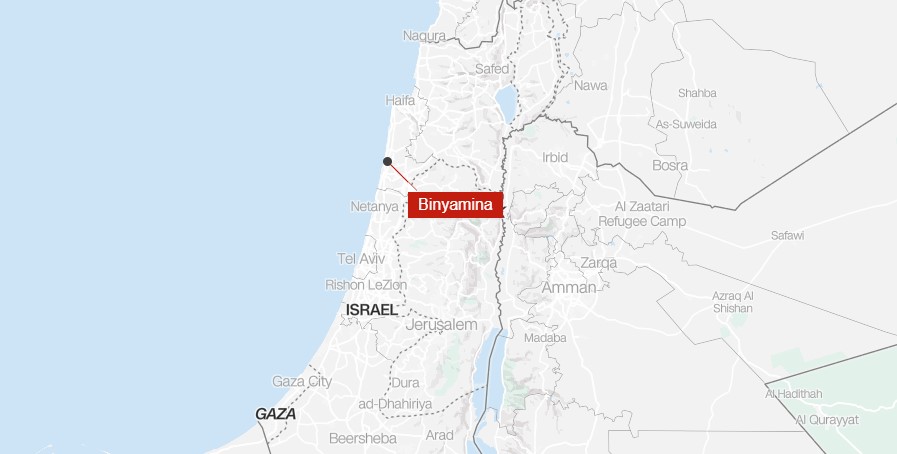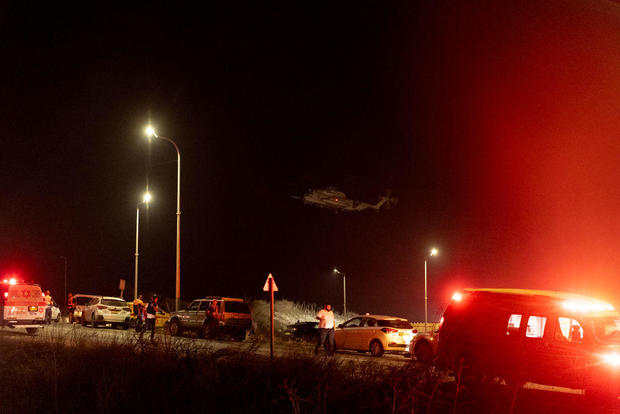In an incident involving an army base situated in the central-northern region of Israel, four Israeli military personnel have tragically succumbed to their injuries, while a significant number exceeding fifty have sustained varying degrees of harm, as per the reports of first responders and the Israeli military.
The occurrence transpiring on Sunday evening, local time, stands as one of the most sanguinary assaults directed towards Israel since the commencement of hostilities in October of the preceding year.
The Israel Defense Forces (IDF) formally announced that an unmanned aerial vehicle (UAV), launched under the auspices of Hezbollah, struck an army base situated in proximity to Binyamina, a municipality situated to the north of Tel Aviv and approximately 40 miles (64 kilometers) from the Lebanese border.
In addition to the fatalities of four soldiers, seven further personnel sustained substantial physical harm, according to the Israel Defense Forces.
As reported by Israel’s Magen David Adom emergency medical services, a total of sixty-one individuals sustained injuries as a result of the incident.
This news follows a declaration made by Hezbollah on Sunday, indicating that they had deployed a substantial number of attack drones targeting an Israeli infantry training facility situated in Binyamina.
The Lebanon-based militant group said the attack was in response to Israeli strikes in Lebanon Thursday that killed 22 people and injured 117, according to the Lebanese Ministry of Health.
The militant organization known as Hezbollah declared that it had specifically targeted the Golani Brigade, an infantry unit of the Israel Defense Forces (IDF) that had been strategically deployed within the southern region of Lebanon. The claim of responsibility for the attack was promptly released shortly after the aforementioned militant group disclosed an audio message received from their deceased leader, Hassan Nasrallah, urging his loyal followers to “defend your people, your family, your nation, your values, and your dignity.”
Earlier on Sunday, the IDF reported that they had successfully intercepted an Unmanned Aerial Vehicle (UAV) launched from Lebanon, although the specific location of the interception was not immediately disclosed. It was unclear at that time whether this incident was directly connected to the injuries sustained by the Golani Brigade.
Within the purview of aerial defense, Israeli systems have consistently demonstrated remarkable dependability. However, on Sunday, a notable anomaly emerged; there were no recorded alerts in the Binyamina region at the time of the attack. This occurrence has prompted inquiries regarding the manner in which the drone managed to penetrate deeply into Israeli territory without detection.
Simultaneously, Hezbollah asserted that it had discharged numerous rockets toward the northern Israeli towns of Nahariya and Acre. This strategic maneuver aimed to engage Israel’s air defense systems while concurrently launching a drone swarm.
“The unmanned aerial vehicles (UAVs) successfully breached the Israeli defense radar systems without being detected. They subsequently reached their intended target, which was the training camp of the elite Golani Brigade in Binyamina,” Hezbollah declared.
Rear Admiral Daniel Hagari, the top spokesperson for the Israel Defense Forces (IDF), stated that the military would conduct a thorough investigation to determine how the drones were able to penetrate the base’s defenses without triggering any alarms.
In a video statement recorded at the base, Rear Adm. Hagari acknowledged, “We will thoroughly investigate this incident and learn from it. The threat posed by UAVs is one that we have been actively addressing since the commencement of the conflict. It is imperative that we enhance our defensive capabilities in light of this emerging threat.”

The Binyamina incident occurs approximately fourteen days following the commencement of Israel’s ground operation in southern Lebanon. The Israel Defense Force (IDF) has maintained that the operation is “localized” and “limited,” although the prevailing circumstances on the ground suggest the potential for a broader-scale invasion.
The Israel Defense Forces (IDF) have promulgated evacuation directives encompassing a substantial portion of Lebanon’s territorial domain. Concurrently, units drawn from four distinct IDF divisions have been deployed to the border region, while an intensive bombardment campaign persists.
Since September 16, when Israel augmented its military operations against Hezbollah, more than 1,500 individuals have regrettably lost their lives, and in excess of 8,000 have sustained injuries within Lebanon. These figures have been meticulously compiled by CNN based on official statements issued by the Lebanese Ministry of Health.
On Sunday, tensions escalated once more when Israeli Prime Minister Benjamin Netanyahu formally requested the withdrawal of United Nations peacekeeping forces from southern Lebanon. This request was made in response to multiple incidents involving the Israeli Defense Forces (IDF) that resulted in injuries to five members of the United Nations Interim Force in Lebanon (UNIFIL).
In response to these attacks, the forty countries that contribute soldiers to the UN peacekeeping mission in Lebanon released a joint statement on Sunday expressing their strong condemnation.
Concurrently, Yoav Gallant, the Minister of Defense for Israel, stated that Israel would not countenance Hezbollah’s reestablishment in border villages located in southern Lebanon following the withdrawal of Israeli troops from the region.
Despite the ground operation targeting its infrastructure, Hezbollah continues to fire dozens of rockets into Israel on daily basis.
The assault that occurred on Sunday also prompts apprehension in regard to Hezbollah’s capacity to utilize long-range drones against Israel, given that it transpired merely two days subsequent to a separate attack during which the IDF stated that two drones were launched from Lebanon.
On Friday, the Israeli military announced that it had successfully intercepted one of the unmanned aerial vehicles (UAVs) that had been detected in its airspace. However, the military did not disclose any information regarding the fate of the remaining UAV. During the incident, which occurred on Friday, warning sirens were activated. Although a nursing home located in the coastal city of Herzliya, in central Israel, sustained some damage, there were fortunately no reported casualties.
Magen David Adom formally proclaimed a mass casualty incident on the evening of Sunday, resulting in the evacuation of sixty-one wounded individuals from the scene. Unfortunately, three individuals sustained severe injuries, and eighteen others suffered moderate trauma.
An official statement released by the emergency service included a quote from a paramedic present at the site, describing it as “a highly challenging scene.”
In a formal statement, Rafi Sheva reported that the incident was designated as a mass casualty event, necessitating the immediate triage and treatment of individuals afflicted with blast-related injuries and shrapnel wounds. The severity of the injuries warranted prompt evacuation of the casualties to medical facilities for comprehensive medical care.
Following the incident in Binyamina, those who sustained injuries were transported to eight separate medical facilities located throughout Israel, as confirmed by Magen David Adom, the national emergency medical service.
The Laniado Hospital, situated in the north-central region of Israel, provided medical care to various individuals who sustained minor injuries.
The official spokesperson, Asahel Shahaf, communicated that a male individual admitted to the emergency treatment facility experienced a fortunate escape when fragments from the unmanned aerial vehicle became lodged within his kippah, a customary head covering worn by Jewish men.
Shahaf formally stated that the shrapnel surprisingly caused no harm to the injured person, calling it “a minor miracle.”




